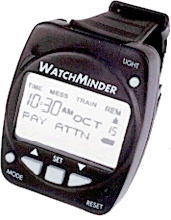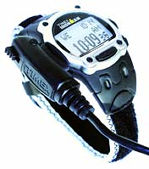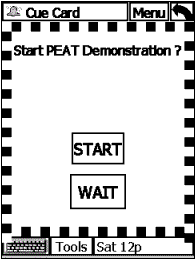|
|
Cognitive Disability
The Center on Human Policy at Syracuse University defines cognitive disability as: "a disability that impacts and individual's ability to access, process, or remember information.".
Wrist Watches
WatchMinder®
The messages are selected  and alarm times are set. At the appointed time, the message is displayed and the watch vibrates for 2.5 seconds. and alarm times are set. At the appointed time, the message is displayed and the watch vibrates for 2.5 seconds.
The message will blink on the screen for five minutes.
The schedule will repeat daily unless you make changes. Messages can be used more than one time a day. The reminder mode has 57 messages that remind the person to do specific tasks, like CALL HOME, MEDS, GO WORK, and DO TEETH. The watch has 16 daily alarms and a person's entire day can be pre-programmed and alarms can be activated at specific times of the day and messages/reminders are displayed.
Timex Ironman Data Link USB, this watch has a  personal organizer, has auditory alerts with text messages. With the PC software, users can set the watch, customize the features and this "computer-to-watch" connection makes watch easy to customize and operate. Microsoft Windows 98SE, 2000 (with Service Pack 1 or higher), ME, XP or higher. personal organizer, has auditory alerts with text messages. With the PC software, users can set the watch, customize the features and this "computer-to-watch" connection makes watch easy to customize and operate. Microsoft Windows 98SE, 2000 (with Service Pack 1 or higher), ME, XP or higher.
Cognitive Disability Software
PEATTM
by Attention Control Systems, Inc.
(Planning and Execution Assistant and Training System) is a program designed to provide cueing  and planning assistance for people with memory and attention disorders. Typical users include patients with traumatic brain injury (TBI), neurodegenerative conditions including Alzheimer's disease, and attention deficit and hyperactivity disorder (ADHD). PEAT lets people with such conditions become more independent by helping them plan daily tasks and keeping them on schedule. and planning assistance for people with memory and attention disorders. Typical users include patients with traumatic brain injury (TBI), neurodegenerative conditions including Alzheimer's disease, and attention deficit and hyperactivity disorder (ADHD). PEAT lets people with such conditions become more independent by helping them plan daily tasks and keeping them on schedule.
PEAT's patented planning software was developed by a NASA computer scientist who develops automatic planning software for robotic spacecraft. The planning software is also based on neuropsychological models of frontal lobe and executive brain functions. PEAT's patented automatic planning features include floating tasks and scripts . PEAT combines advanced artificial intelligence software with graphic displays, extensive use of selection menus, personalized verbal and audio signals, and other features designed for people with cognitive, perceptual, and motor deficits. A few of PEAT's features include:
Specialized user interface designed for people with visual, cognitive, and motor disorders.
Uses graphics and sounds to remind users when to start and stop tasks.
Automatic rescheduling whenever tasks are delayed, interrupted, or canceled (U.S. Patent #6,047,260)
Customization for individual needs and reconfiguration as needs change.
"Scripts" that describe hierarchical, multi-step activities and complex daily routinesb
Floating tasks that can be scheduled anytime within a specified time window.
Integration with sounds and pictures .
|
|


 and alarm times are set. At the appointed time, the message is displayed and the watch vibrates for 2.5 seconds.
and alarm times are set. At the appointed time, the message is displayed and the watch vibrates for 2.5 seconds.  personal organizer, has auditory alerts with text messages. With the PC software, users can set the watch, customize the features and this "computer-to-watch" connection makes watch easy to customize and operate. Microsoft Windows 98SE, 2000 (with Service Pack 1 or higher), ME, XP or higher.
personal organizer, has auditory alerts with text messages. With the PC software, users can set the watch, customize the features and this "computer-to-watch" connection makes watch easy to customize and operate. Microsoft Windows 98SE, 2000 (with Service Pack 1 or higher), ME, XP or higher.
 and planning assistance for people with memory and attention disorders. Typical users include patients with traumatic brain injury (TBI), neurodegenerative conditions including Alzheimer's disease, and attention deficit and hyperactivity disorder (ADHD). PEAT lets people with such conditions become more independent by helping them plan daily tasks and keeping them on schedule.
and planning assistance for people with memory and attention disorders. Typical users include patients with traumatic brain injury (TBI), neurodegenerative conditions including Alzheimer's disease, and attention deficit and hyperactivity disorder (ADHD). PEAT lets people with such conditions become more independent by helping them plan daily tasks and keeping them on schedule.